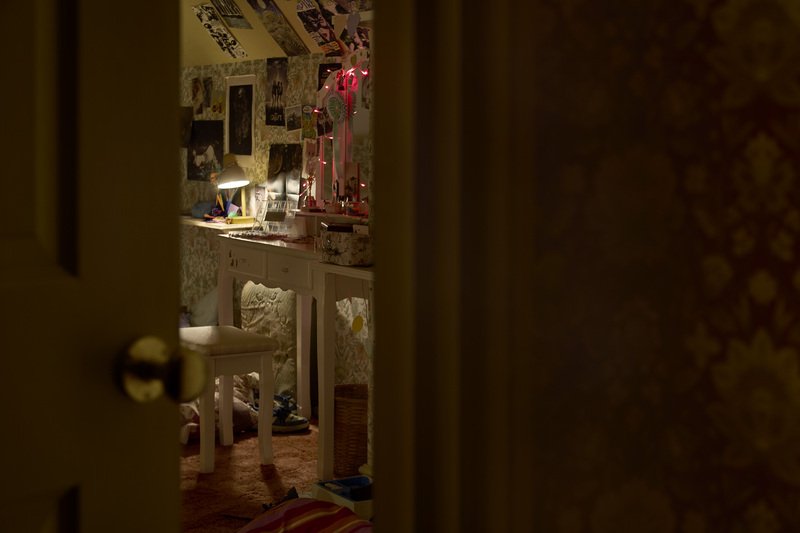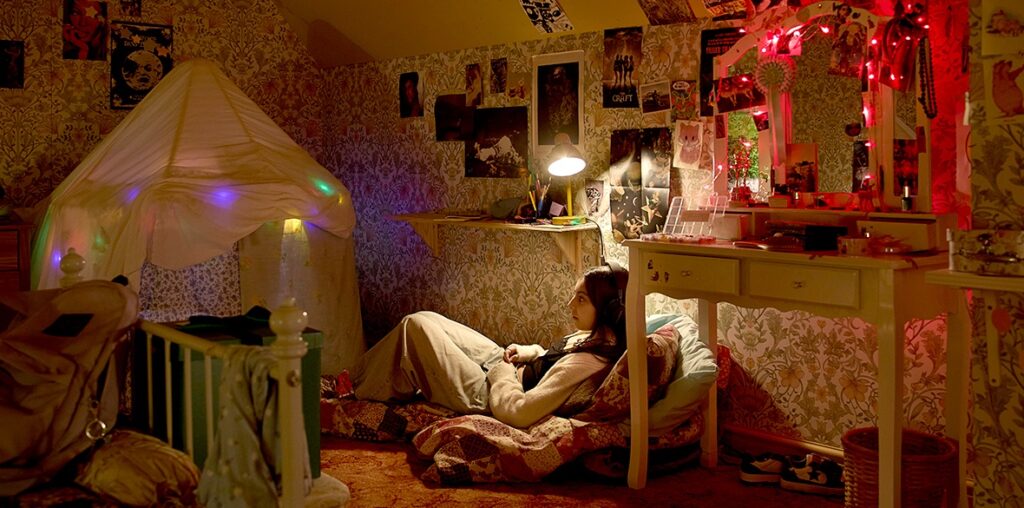Activating Sight, Sound, and Smell
We are used to vision taking the lead in immersive experiences. Yet, here we are limited in our sight, deliberately. You will spend your time inside the experience in dim lighting or, at times, complete darkness. Lighting, masterfully executed by Simon Wilkinson, becomes a scarce resource. The light takes the role of our guide, and despite its occasional deception, we are bound to obey it. Like puppets in a tale, we give up control, trusting the light will lead us out of the nightmare.
Now, if touch communicates the emotional story beats and vision serves as our guide, what role does hearing play? Inside Viola’s Room, we are instructed to wear headphones and immerse ourselves in the tale narrated by Helena Bonham Carter’s disembodied voice. Initially, one might think the spoken narrative is crucial for context and substance. However, it proves confusing and hard to follow, frustrating those relying solely on it. The best approach is to engage all senses to grasp the essence of the show.
Here, hearing serves not to elucidate context but assumes a different role. In Viola’s Room, it evokes feelings of isolation, intimacy, and enchantment. The voice is there to entrance us. Isolated by the headphones from our fellow participants, anxious not to miss a single word, we forfeit our ability to speak. Going through the experience in solitude we deepen our connection with this world on an intimate level.
Finally, smell is a tricky sense to activate in immersion, yet it holds incredible power in delivering realism. In this show the attic has the distinct musty smell to it, that lingers on your clothes. The church smells like frankincense and myrrh. These aromas are subtle, leaving us unsure of their origin, but they are meticulously chosen to deliver the final dose of realism that completes our immersion.
Broad Impacts of Immersive Storytelling
Punchdrunk’s commitment to immersive storytelling shines through in Viola’s Room, offering a carefully planned experience. Each sense is assigned a role that contributes to the larger narrative. The audience is in awe from the moment they enter until they retrieve their shoes from a box labelled with their name. The experience invites personal interpretation, fostering a profound connection with the narrative that extends well beyond the performance.
Beyond mere entertainment, immersive technologies offer significant promise across diverse industries. In education, virtual simulations provide a safe and controlled environment for training, enhancing information retention. Healthcare professionals utilise VR for therapy and pain management, harnessing its immersive nature to encourage empathy and emotional connection, which are also valuable in marketing strategies.
On the whole, Punchdrunk’s approach serves as a good example of how businesses can creatively leverage immersive technology to enhance brand storytelling and customer engagement. By strategically utilising sensory stimulation, businesses can shape immersive experiences that create deeper connections with their audience. This approach not only captures attention but also cultivates lasting impressions that excels traditional marketing methods. Understanding how each sense can enhance the experience allows businesses to innovate and craft narratives that resonate deeply with their audience.
Contact us
Are you looking to create an innovative immersive technology project in virtual or augmented reality? Then feel free to drop us an email at info@sbanimation.com, or give us a call on +44 (0)207 148 0526. We would be happy to help.
We also post industry related content to our LinkedIn company page, why not give us a follow?










